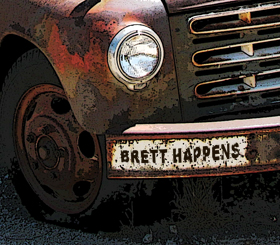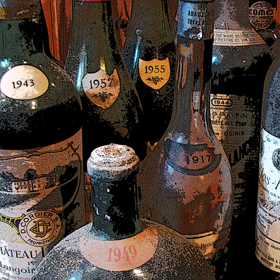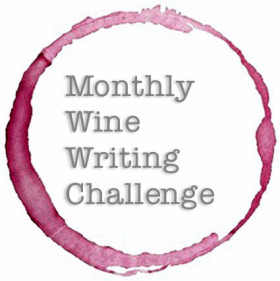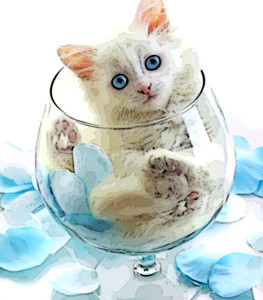Wine Evaluation; The Nose Knows No’s Not An Option.
Chapter Three, Part Six.
 In certain wine circles people share the opinion that the difference between an aroma and a bouquet has to do with the age of the wine. They believe that young wines display aroma, and only when wine reaches maturity will it develop a bouquet. While studying for my Sommelier certificate, I was taught that aroma comes from the grape variety and bouquet stems from the vinification process. I, of course, don’t subscribe to either school of thought.
In certain wine circles people share the opinion that the difference between an aroma and a bouquet has to do with the age of the wine. They believe that young wines display aroma, and only when wine reaches maturity will it develop a bouquet. While studying for my Sommelier certificate, I was taught that aroma comes from the grape variety and bouquet stems from the vinification process. I, of course, don’t subscribe to either school of thought.
Visual Wine Inspection; Looking For Clarity, Color & Intensity.
Chapter Three, Part Five.
 When analyzing wine a vigilant visual inspection will give you some clues as to the condition, age and style of the wine. Visual indicators may also offer you the first tip-off that the wine is flawed. For example, bad wine is often cloudy, off-color, or has a cute animal on the label.
When analyzing wine a vigilant visual inspection will give you some clues as to the condition, age and style of the wine. Visual indicators may also offer you the first tip-off that the wine is flawed. For example, bad wine is often cloudy, off-color, or has a cute animal on the label.
Begin your visual examination by checking the wine for clarity. Wine can become cloudy if bacterium gets inside the bottle, but before you turn that murky bottle into a grab bag gift at the office Christmas party you should know there is another cause for cloudiness that is not considered a flaw.
Read MoreThe Monthly Wine Writing Challenge; My Best Friend Wine.
“Writing is a lonely job, unless you’re a drinker, in which case you always have a friend within reach.” Emilio Estevez
 If you’re a wine aficionado, at one time or another you’ve probably said, “We can’t open the good wine when they come over.” Sure you love your friends but you rationalize your decision with sentiments like “they couldn’t possibly appreciate the wine we drink”.
If you’re a wine aficionado, at one time or another you’ve probably said, “We can’t open the good wine when they come over.” Sure you love your friends but you rationalize your decision with sentiments like “they couldn’t possibly appreciate the wine we drink”.
Obviously these wine locusts are three rungs beneath you on the evolutionary ladder and the only thing they have in common with you is opposable thumbs – which they’ll use to drink all your expensive wine.
Read MoreVisual Wine Inspection, Bubble Trouble & Cosmic Crystals.
Chapter Three, Part Four.
 The first step of wine analysis is to take a good look at your wine. For this you will need an acceptable wine glass. You may be emotionally attached to that old Flintstones tumbler you’ve had since grade school, but it’s time to buy some nice stemware and part ways with Fred and Barney.
The first step of wine analysis is to take a good look at your wine. For this you will need an acceptable wine glass. You may be emotionally attached to that old Flintstones tumbler you’ve had since grade school, but it’s time to buy some nice stemware and part ways with Fred and Barney.
A good-sized, tulip-shaped glass with a thin rim will do nicely for most wines, providing it is clear. Avoid glasses that are tinted or painted. I’m sorry gentlemen but the logo of your favorite sports franchise may be appropriate glassware for the man-cave, but it’s unacceptable on your wine glasses. I know you’re reluctant to give up the team logo but if your wives were on the Pulitzer Prize committee, this stipulation would make Wine Snark a shoe-in for the award.
Read MoreGet In Touch With Texture; Tannin Versus Dryness.
Chapter Two, Part Three.
 Texture is paramount to appreciating wine so I put a great deal of emphasis on deciphering its tactile sensations. When describing wine make note not just of the aroma and taste, but of how the wine feels. Now I know a lot of you guys get a little queasy talking about your feelings, so I promise to get through this quickly, even if it takes all night.
Texture is paramount to appreciating wine so I put a great deal of emphasis on deciphering its tactile sensations. When describing wine make note not just of the aroma and taste, but of how the wine feels. Now I know a lot of you guys get a little queasy talking about your feelings, so I promise to get through this quickly, even if it takes all night.
Wines come in a variety of textures, some of which will appeal to you, and some of which will not. When you first taste wine ask yourself “How do I describe the texture of this wine?” Does it feel harsh or silky? Is it lean and austere or rich and flamboyant? Do you find it thin or fat, wimpy or muscular? The weight of wine is also perceived by your sense of touch. Does the wine feel light or heavy in your mouth?
Many wines are described as crisp in texture. You may like that quality in a Pinot Grigio or a $100 bill but dislike it in Grenache. Other wines are said to be creamy. Once again, this may be a desirable trait for Merlot or some Chardonnays but creamy is not a trait you look for in Navy seals or Grüner Veltliner.
Read More



















